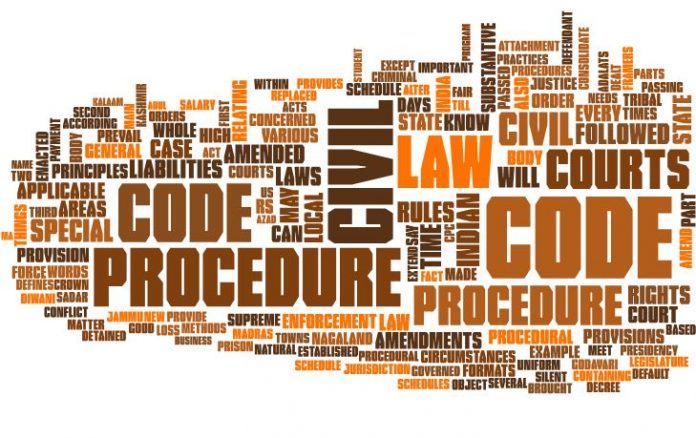This article has been written by Anindita Deb, a student from Symbiosis Law School, NOIDA. This article discusses different provisions and important aspects of Order 7 Rule 1 under the Code of Civil Procedure.
This article has been published by Sneha Mahawar.
Table of Contents
Introduction
In a country with a population like India’s, you can only imagine the huge pile of case files the courts are dealing with on a daily basis. The smallest of disputes are taken to court because the populace places its faith in the legal system and believes in the justice it provides. But imagine there being no guidelines and framework to serve this justice. The judges would deliver judgments at whim, and procedural requirements would become subjective. This is where procedural statutes come in. The Code of Civil Procedure, 1908 (CPC), is the procedural law that administers and regulates civil proceedings in India. So next time you file a land dispute case or an unfair termination complaint, make sure you follow the procedure laid down therein.
A plaint is an essential element in any civil case. Without it, the judge would be incapable of arriving at a decision. Why, you ask? What is a plaint, you wonder? Well, think no more. Keep reading to find out all about a plaint and what it should contain as per the provisions laid down under Order 7 Rule 1 of the Civil Procedure Code.
What is a plaint
The term ‘plaint’ has not been defined anywhere under the Civil Procedure Code. If one simply tries to put it down, a plaint is a document containing the pleadings or contentions that the plaintiff wishes to put forward before the court. It is a statement that specifies the cause of action of the plaintiff in coming to court and it also mentions what relief the plaintiff seeks from the court.
The Karnataka High Court made an attempt at defining what a plaint is in the case of Girija Bai v. Thakur Das (1967):
“A plaint can be said to be a statement of claim, a document, by presentation of which the suit is instituted. Its object is to state the grounds upon which the assistance of the court is sought by the plaintiff. It is the pleading of the plaintiff.”
Particulars of a plaint as per Order 7 Rule 1 CPC
Order 7 of the Civil Procedure Code has eight rules which deal with different requisites and provisions relating to plaints. Rule 1 of the Order mentions the particulars which must be contained in a plaint. The following are the particulars as mentioned within Rule 1:
- The name of the court before which the suit has been brought. [Rule 1(a)]
- The name, description, and place of residence of the plaintiff. [Rule 1(b)]
- The name, description, and place of residence of the defendant, as far as it is possible to ascertain it. [Rule 11(c)]
- If the plaintiff or defendant to the suit is a minor, or of unsound mind, a statement must be attached to that effect. [Rule 1(d)]
- The facts which constitute the cause of action and when it arose. [Rule 1(e)]
- The facts which prove that the court to which the plaint is being submitted has the jurisdiction to hear the case. [Rule 1(f)]
- The relief which the plaintiff is claiming. [Rule 1(g)]
- In cases where the plaintiff has waived or allowed setoff of a portion of his claim, the amount thus waived or allowed. [Rule 1(h)]
- A declaration of the value of the lawsuit’s subject matter for jurisdictional and monetary purposes, to the extent that the case permits. [Rule 1(i)]
Important aspects of Order 7 Rule 1 CPC
This section aims to discuss some of the above mentioned particulars in detail in order to provide a better understanding to the readers regarding the same.
Parties to the suit
Every suit must have two parties to it, i.e., the plaintiff and the defendant. There can be two or more plaintiffs or two or more defendants as well, but one plaintiff and one defendant must be a party to the suit for the court to hear it. Each and every particular of the plaintiff and defendant, such as name, father’s name, age, place of residence, etc., which will be used to identify the parties to the suit, has to be mentioned in the plaint.
Cause of action
A cause of action is a prerequisite for filing a suit. The plaint will be rejected immediately if there is no cause of action, and hence, the cause of action must be clearly mentioned in the plaint. The expression ‘cause of action’ has not been defined anywhere in the Code, but it can be defined as a bundle of essential facts that the plaintiff must necessarily prove in order to succeed. The cause of action can also be said to be that which gives the plaintiff his right to relief against the defendant. It forms the very foundation of a suit.
However, it must be kept in mind that the cause of action does not have anything to do with what defence the defendant puts in, or with the character of the relief that the plaintiff is seeking. It is merely a medium through which the plaintiff prays to the court to deliver a judgment in his favour. The determination of whether or not the facts constitute a cause of action depends entirely on the facts of the case, and the court is supposed to consider the substance of the matter rather than the forms of action.
It is important for the plaintiff to mention in his plaint as to when the cause of action arose. This will help the defendant as well as the court to determine from the plaint whether or not the cause of action that the plaintiff has alleged in his plaint has arisen in fact and in law.
The Supreme Court of India made the following observation with respect to cause of action in the case of Kuldeep Singh v. Ganpat Lal (1995):
“The object underlying Order 7 Rule 1(e), which requires that the plaint shall contain the particulars about the facts constituting the cause of action and when it arose, is to enable the court to find out whether the plaint discloses the cause of action because the plaint is liable to be rejected under Order 7 Rule 11 CPC if it does not disclose the cause of action. The purpose behind the requirement that the plaint should indicate when the cause of action arose is to help the court in ascertaining whether the suit is not barred by limitation. Any error on the part of the plaintiff in indicating the date on which the cause of action arose would be of little consequence if the cause of action had arisen on the date on which the suit was filed and the suit was within limitation from the said date. The error in mentioning the date on which the cause of action had arisen in the plaint in such a case would not disentitle the plaintiff from seeking relief from the court in the suit.”
For determining whether the facts mentioned by the plaintiff constitute the cause of action or not, the court has to look into whether such facts constitute the material, essential, or integral part of the cause of action. If it is, then it forms the cause of action, if not, then it does not form the cause of action.
Jurisdiction of the court
The plaint must contain all the information necessary to establish the court’s pecuniary and territorial jurisdiction over the dispute at hand. When a defendant challenges a court’s capacity to hear a case, the court may pose the question in that manner and decide on it before judgment on other matters. The plea of jurisdiction has to be decided on the basis of arguments in the plaint.
Valuation
For the purpose of the court’s pecuniary jurisdiction and court fees, the plaintiff must specify in the plaint the valuation of the suit’s subject matter. When seeking to recover money, for example, the valuation of the subject matter may occasionally be the same for both reasons. However, there are situations when two assessments may be in conflict, such as in litigation for a declaration, an injunction, or the possession of the real estate. In this situation, the plaintiff must expressly identify the value of the action in order for the court to have jurisdiction over it and in order to determine court costs.
Judicial pronouncements
Jaharlal Pagalia v. Union of India (1958)
In this case, a request to alter the plaint was made. The High Court of Calcutta made the observation while approving the decree that the facts supporting the claim must come before the lawsuit. The cause of action must be stated under Section 80 (Notice) of the CPC. The cause of action and the date it occurred must be disclosed as provided under Order 7, Rule 1(e) even though the writing of the plaint is a procedural matter. The plaintiff lacks locus standi in the absence of a cause of action. Even though the plaintiff had shown a delay, the court permitted him to alter the plaint in accordance with Order 6 Rule 17 because the delay had not negatively impacted either of the parties.
P.M. Diesels Ltd. v. Patel Field Marshal Industries (1995)
In this case, the defendants protested, claiming that the court lacked the jurisdiction to hear the case. Even the plaint did not contain any information demonstrating the suit’s territorial jurisdiction. The court held that, according to Order 7 Rule 1, the plaintiff must demonstrate the court’s jurisdiction. The plaintiff in the present case did not carry out his obligations. Due to the lack of territorial and financial jurisdiction, the court declined to grant the relief of an injunction, regardless of the merits of the case.
Sh. Suresh Kumar Anand v. Sh. Sudhish C. Anand (2018)
In this case, the plaintiff had filed a lawsuit seeking a mandatory injunction, damages, and mesne profits. The absence of a documented licensing deed was acknowledged by the court while discussing court costs. The plaintiff, the court said, had not complied with the specifics of Order 7 Rule 1(i) CPC. The market value of the subject property, which is a relevant fact, should have been disclosed.
Conclusion
Order 7 plays an indispensable role in ensuring that the courts do not have to deal with frivolous cases and makes it easier for the plaintiff to file a plaint with ease and for the courts to determine whether or not there is a cause of action for further hearing. More importantly, the Order has also ensured that the jurisdiction of the court to try the case is proved in the plaint so that there isn’t an additional dispute about the court’s jurisdiction. So the next time you are looking to file a civil suit for damages, make sure your plaint contains all the particulars mentioned within this article so that your plaint does not get rejected by the court on grounds of not meeting the requirements mentioned under Order 7 Rule 1.
References
- C.K. Takwani, Civil Procedure (9th Edition)
- https://www.lawyersclubindia.com/articles/landmark-judgements-on-order-7-rule-1-of-civil-procedure-code-14324.asp
Students of Lawsikho courses regularly produce writing assignments and work on practical exercises as a part of their coursework and develop themselves in real-life practical skills.
LawSikho has created a telegram group for exchanging legal knowledge, referrals, and various opportunities. You can click on this link and join:
Follow us on Instagram and subscribe to our YouTube channel for more amazing legal content.
 Serato DJ Crack 2025Serato DJ PRO Crack
Serato DJ Crack 2025Serato DJ PRO Crack











 Allow notifications
Allow notifications


